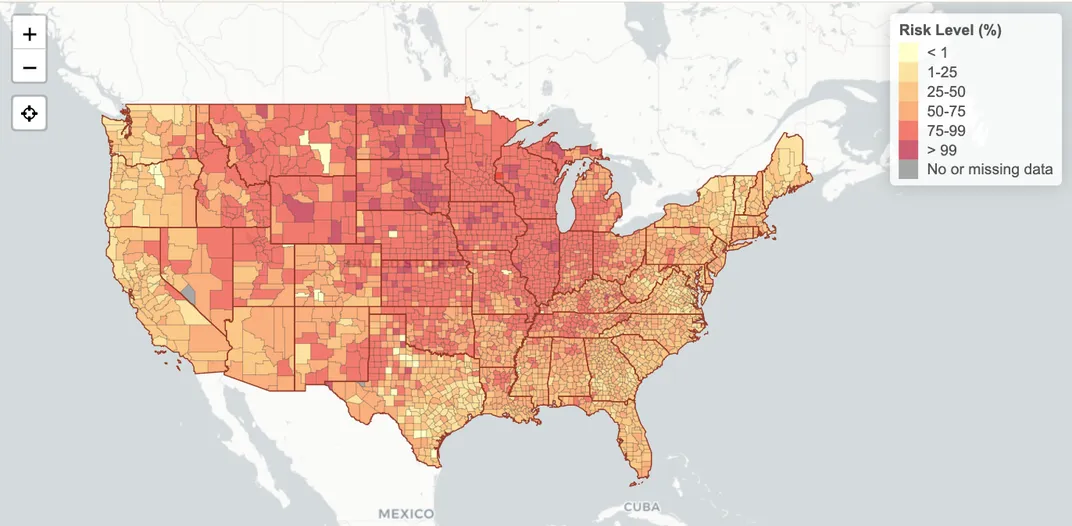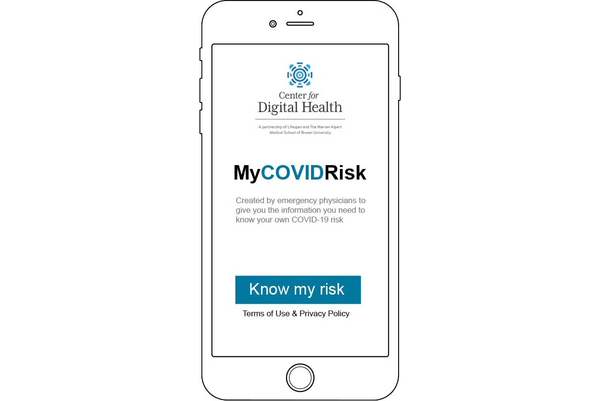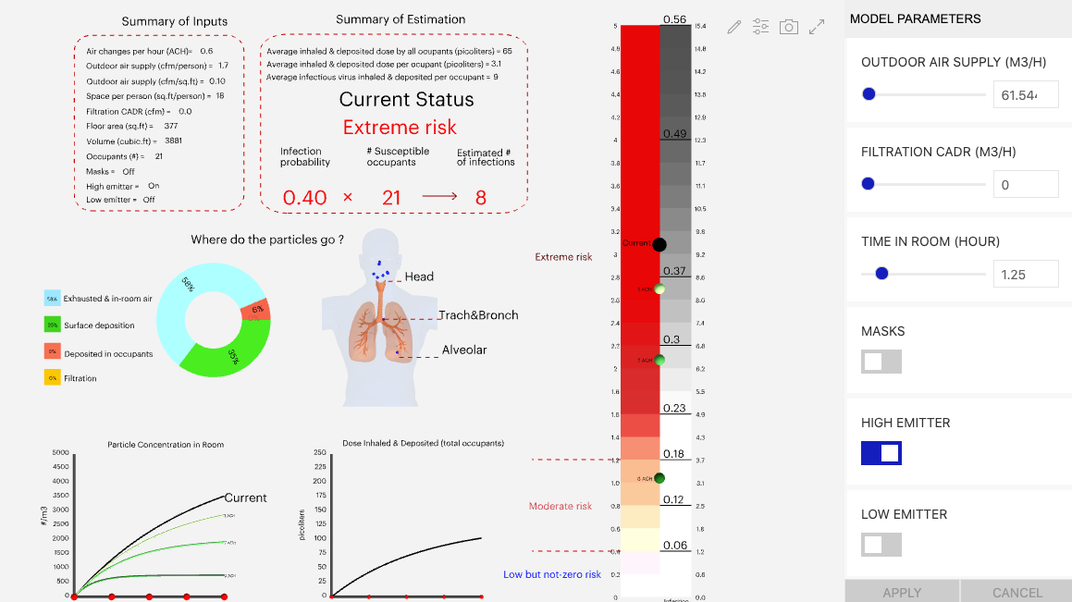Five Online Tools for Evaluating Covid-19 Risk Ahead of the Holidays
Of course, the safest option is holding events virtually and skipping in-person, indoor gatherings altogether this year
/https://tf-cmsv2-smithsonianmag-media.s3.amazonaws.com/filer/ad/d3/add380b2-db2b-42e8-a950-0a3a868f248b/2020_nov17_toolsrisk.png)
In a normal year, the holiday season an opportunity for families and friends to gather and celebrate special days with food and merriment. But against a backdrop of the Covid-19 pandemic, many are now trying to puzzle out safe ways to celebrate.
2020’s holiday season has already started—Diwali was November 14—and a poll conducted by Ohio State University found that over the next few months, 38 percent of Americans plan to attend gatherings of ten or more people, Zeeshan Aleem reports for Vox. To help people figure out ways to reduce the risks of gatherings like these, researchers around the country have developed free online tools that visualize different facets of the pandemic’s dangers.
Experts warn that people shouldn’t rely too heavily on any single risk-assessment tool because they can give a false sense of security, Allyson Chiu reports for the Washington Post. But for those who plan to gather this holiday season, the tools might help come up with creative ways to reduce risk.
Georgia Institute of Technology’s Interactive Map

What this tool can tell you: This interactive map shows the likelihood of encountering someone with a coronavirus infection depending on how many people are at the event, and where the event is taking place.
The tool could be used by government officials deciding how to design public health policies, Deborah Netburn reports for the Los Angeles Times. But it could also help holiday travelers assess the risks of their origins and destinations.
It’s also the only peer-reviewed tool available. Its creators published a paper about the research behind the tool in Nature Human Behavior on November 9.
What this tool can’t tell you: The map doesn’t show the risk of contracting the virus at an event, George Washington University professor of medicine and health policy William Borden tells the Washington Post. It doesn’t take into account whether the event is held indoors or outdoors, whether people are wearing masks or attendees’ behavior before the event.
Brown University’s Covid-19 Risk App

What this tool can tell you: This tool looks at what kind of event is being held; how many people will be there and for how long; the event’s location; and how many people will be wearing masks. Considering those factors, it calculates the risk estimate from low to very high. The app then walks the user through a series of suggestions to reduce risk.
“What we wanted to do was help people directly visualize how their behavior can directly impact their risk of contracting the virus,” Elizabeth Goldberg, an emergency physician at Brown University, tells Kelcie Pegher at the Los Angeles Times.
What this tool can’t tell you: Like the Georgia Institute of Technology’s interactive map, this tool doesn’t take into account individuals’ behavior before an event. (For example: Are they eating indoors at resturants? Are they working remotely?) The app developers plan to translate the app in several languages, they tell the Los Angeles Times, but it is currently available in English.
University of Colorado Boulder’s Models
What this tool can tell you: A team at the University of Colorado Boulder created a model to determine the risk of coronavirus transmission in different spaces, like offices, classrooms or indoor house parties, Maya Wei-Haas and Kennedy Elliot reported for National Geographic in August.
The charts published in National Geographic allow people to alter the local infection rate, the square feet per person and the effectiveness of masks that people are wearing. After taking those variables into account, the charts show how likely infection becomes over the course of three hours in the space.
What this tool can’t tell you: A few factors in the model might be difficult for an average user to guess before an event, like the percent effectiveness of the masks that other people will be wearing. The model also doesn’t account for how risk increases when you stand closer to an infected person, where the virus-carrying droplets would be more concentrated.
University of Oregon’s Aerosol Risk Estimator

What this tool can tell you: This tool uses detailed information about the design of a room to estimate the risk of Covid-19 transmission in that space. You can input information about the room’s floor plan, ceiling height, ventilation and filtration systems. The tool also asks how many people will be in the space, and for how long, and whether or not people will wear masks.
By getting into the nitty-gritty of an event space, it addresses some of the gaps in other tools.
What this tool doesn’t tell you: This tool doesn’t take an event’s geographic location into account and how many Covid-19 cases there currently are locallu. It also doesn’t attempt to estimate the likelihood of an infectious person showing up. But it does allow you to add a hypothetical infectious person to your party.
State and CDC Travel Guidelines
None of the tools can anticipate every possible scenario, and any event where people gather comes with some risk of Covid-19 transmission. The U.S. has recorded more than 100,000 new cases per day every day since November 4, and cases surged in Canada after their Thanksgiving in October.
Several states are putting restrictions in place for the next few months. In some places, indoor gatherings are limited to ten people or fewer. In Oregon, the limit is six people to an indoor gathering from no more than two households, AARP’s Dena Bunis and Jenny Rough report. Some states also require out-of-state visitors to quarantine for two weeks.
According to the CDC's guidelines for holiday gatherings, hosts should limit the number of attendees at any event, events should take place outdoors, and guests should wear masks as much as possible. For example, holidays could be celebrated with a quick visit to see family, but without a meal, so everyone could stay masked.
“We’re going to look back at what happened during this holiday season and ask ourselves, ‘Were we part of the solution or were we part of the problem?’” says Iahn Gonsenhauser, chief quality and patient safety officer at Ohio State University’s Wexner Medical Center, in a statement. “When you’re gathered together around the table, engaged in conversation, sitting less than six feet apart with your masks down, even in a small group, that’s when the spread of this virus can really happen.”
Of course, the safest option would be to hold events virtually, and skip in-person, indoor gatherings, especially big groups, altogether this year. At a Mississippi State Medical Association video conference, the group's president Mark Horne had a sober message for attendees, reports Ashton Pittman for the Mississippi Free Press.
“We don’t really want to see Mamaw at Thanksgiving and bury her by Christmas,” Horne says. “It’s going to happen. You’re going to say hi at Thanksgiving, it’s so nice to see you, and you’re either going to be visiting her by Facetime in the ICU or planning a small funeral by Christmas."